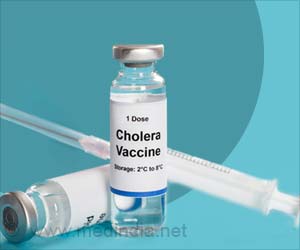Harnessing the protective molecules may offer a new way to treat cholera, which spreads through contaminated water.

‘The MIT team identified a specific type of glycan that can prevent Vibrio cholerae from producing the toxin that usually leads to severe diarrhea.’





If these glycans could be delivered to the site of infection, they could help strengthen the mucus barrier and prevent cholera symptoms, which affect up to 4 million people per year. Because glycans disarm bacteria without killing them, they could be an attractive alternative to antibiotics, the researchers say. “Unlike antibiotics, where you can evolve resistance pretty quickly, these glycans don’t actually kill the bacteria. They just seem to shut off gene expression of its virulence toxins, so it’s another way that one could try to treat these infections,” says Benjamin Wang PhD ’21, one of the lead authors of the study.
Julie Takagi PhD ’22 is also a lead author of the paper. Katharina Ribbeck, the Andrew and Erna Viterbi Professor of Biological Engineering at MIT, is the senior author of the study, which appears today in the EMBO Journal.
Other key members of the research team are Rachel Hevey, a research associate at the University of Basel; Micheal Tiemeyer, a professor of biochemistry and molecular biology at the University of Georgia; and Fitnat Yildiz, a professor of microbiology and environmental toxicology at the University of California at Santa Cruz.
Mucus Molecules Prevent Cholera Infection
In recent years, Ribbeck and others have discovered that mucus, which lines much of the body, plays a key role in controlling microbes. Ribbeck’s lab has showed that glycans — complex sugar molecules found in mucus — can disable bacteria such as Pseudomonas aeruginosa, and the yeast Candida albicans, preventing them from causing harmful infections.Most of Ribbeck’s previous studies have focused on lung pathogens, but in the new study, the researchers turned their attention to a microbe that infects the gastrointestinal tract. Vibrio cholerae, which is often spread through contaminated drinking water, can cause severe diarrhea and dehydration. Vibrio cholerae comes in many strains, and previous research has shown that the microbe becomes pathogenic only when it is infected by a virus called CTX phage.
Advertisement
In order for this “toxigenic conversion” to occur, the CTX phage must bind to a receptor on the surface of the bacteria known as the toxin co-regulated pilus (TCP). Working with mucin glycans purified from the pig gastrointestinal tract, the MIT team found that glycans suppress the bacteria’s ability to produce the TCP receptor, so the CTX phage can no longer infect it.
Advertisement
When Vibrio cholerae infects the epithelial cells that line the gastrointestinal tract, the cells begin overproducing a molecule called cyclic AMP. This causes them to secrete massive amounts of water, leading to severe diarrhea. The researchers found that when they exposed human epithelial cells to Vibrio cholerae that had been disarmed by mucin glycans, the cells did not produce cyclic AMP or start leaking water.
The researchers then investigated which specific glycans might be acting on Vibrio cholerae. To do that, they worked with Hevey’s lab to create synthetic versions of the most abundant glycans found in the naturally occurring mucin samples they were studying. Most of the glycans they synthesized have structures known as core 1 or core 2, which differ slightly in the number and type of monosaccharides they contain.
The researchers found that core 2 glycans played the biggest role in taming cholera infection. It is estimated that 50 to 60 percent of people infected with Vibrio cholerae are asymptomatic, so the researchers hypothesize that the symptomatic cases may occur when these cholera-blocking mucins are missing.
“Our findings suggest that maybe infections occur when the mucus barrier is compromised and is lacking this particular glycan structure,” Ribbeck says.
She is now working on ways to deliver synthetic mucin glycans, possibly along with antibiotics, to infection sites. Glycans on their own cannot attach to the mucosal linings of the body, so Ribbeck’s lab is exploring the possibility of tethering the glycans to polymers or nanoparticles, to help them adhere to those linings. The researchers plan to begin with lung pathogens, but also hope to apply this approach to intestinal pathogens, including Vibrio cholerae.
“We want to learn how to deliver glycans by themselves, but also in conjunction with antibiotics, where you might need a two-pronged approach. That’s our main goal now because we see so many pathogens are affected by different glycan structures,” Ribbeck says.
Source-Eurekalert









